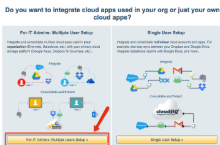In today’s digital-first world, businesses rely on a growing number of cloud-based applications to manage workflows, data, and customer interactions. From CRMs and project management tools to accounting software and communication platforms, the cloud has become the backbone of modern business operations.
However, managing multiple applications in silos can quickly lead to inefficiencies, data duplication, and workflow bottlenecks. This is where cloud app integration comes in. By seamlessly connecting applications, businesses can improve productivity, automate processes, and gain real-time visibility into their operations.
In this guide, we’ll break down how to integrate cloud apps effectively, explore integration methods, and highlight the best practices and tools to ensure smooth implementation.
Why Cloud App Integration Matters
Before diving into the “how,” it’s essential to understand the “why.” Integrating cloud applications helps organizations:
- Eliminate Data Silos: Ensure consistent data across platforms like CRM, ERP, and accounting systems.
- Improve Productivity: Automate repetitive tasks and reduce manual data entry.
- Enhance Collaboration: Enable teams to access unified information, improving decision-making.
- Scale Operations: Add or replace applications without disrupting workflows.
For example, integrating Slack with project management tools like Asana or Trello allows teams to receive instant updates, reducing the need to switch between platforms.
Methods for Cloud App Integration
There are several ways businesses can integrate cloud applications, depending on their size, needs, and budget.
1. Native Integrations
Many SaaS providers offer built-in integrations with other apps. For instance, Salesforce can connect directly with platforms like HubSpot or QuickBooks.
Pros:
- Easy to set up
- No coding required
- Reliable and supported by vendors
Cons:
- Limited customization
- May not support all business needs
2. Integration Platforms as a Service (iPaaS)
Tools like Zapier, MuleSoft, and Workato provide pre-built connectors for hundreds of applications. These platforms act as a bridge, allowing seamless data flow.
Pros:
- Scalable and flexible
- Wide range of supported apps
- No need for in-house developers
Cons:
- Subscription costs can add up
- Complex workflows may require advanced configuration
3. API-Based Integration
For companies with unique requirements, developers can build custom integrations using APIs. Most modern apps offer robust APIs that allow direct communication between systems.
Pros:
- Highly customizable
- Tailored to specific business workflows
- Supports complex use cases
Cons:
- Requires technical expertise
- Longer implementation timelines
- Ongoing maintenance needed
Step-by-Step Guide: How to Integrate Cloud Apps
Follow these steps to ensure a smooth and effective integration process.
Step 1: Identify Business Needs
- Define which apps need integration (e.g., CRM, ERP, HR tools).
- Map out workflows that require automation.
- Determine pain points such as duplicate data entry or lack of visibility.
Step 2: Evaluate Integration Options
- Check for existing native integrations.
- Consider an iPaaS provider if multiple apps are involved.
- Choose API-based integration for advanced customization.
Step 3: Develop a Data Strategy
- Standardize data formats across systems.
- Set rules for data synchronization and conflict resolution.
- Ensure compliance with security and privacy regulations (e.g., GDPR, HIPAA).
Step 4: Implement Integration
- Use sandbox environments for testing.
- Start small (e.g., connect CRM and email marketing first).
- Expand gradually to other apps.
Step 5: Monitor and Optimize
- Continuously monitor integration performance.
- Use analytics to measure ROI and identify areas of improvement.
- Update integrations as business needs evolve.
Best Practices for Cloud App Integration
To maximize results, businesses should follow these best practices:
- Prioritize Security
- Use encryption and secure authentication methods (e.g., OAuth 2.0).
- Regularly update credentials and monitor access logs.
- Ensure Scalability
- Choose solutions that grow with your business.
- Avoid vendor lock-in by selecting open platforms with broad compatibility.
- Leverage Automation
- Automate repetitive tasks like data syncing and reporting.
- Free up employees for higher-value work.
- Engage Stakeholders Early
- Involve IT, operations, and end-users in the planning phase.
- Collect feedback to refine integration workflows.
- Regularly Audit Integrations
- Check for outdated connectors.
- Optimize workflows for efficiency.
Tools for Seamless Cloud App Integration
Here are some popular tools businesses use to connect cloud applications:
- Zapier – Ideal for small to medium businesses needing simple automation.
- MuleSoft – Enterprise-level integration with advanced capabilities.
- Workato – A balance between ease of use and robust automation.
- Integromat (Make) – Flexible platform with visual workflows.
When selecting a tool, consider factors such as pricing, scalability, and compatibility with your existing apps.
Challenges in Cloud App Integration
Despite the benefits, integration projects often face challenges:
- Data Inconsistency: Different apps may use varied data structures.
- Security Risks: More integrations mean more potential vulnerabilities.
- Complex Workflows: Large organizations may require advanced coordination.
- Vendor Lock-In: Relying too heavily on one platform can limit flexibility.
Proactively addressing these challenges ensures smoother implementation and long-term success.
Future of Cloud App Integration
With the rise of AI and machine learning, cloud integrations are becoming smarter. Predictive analytics, automated error handling, and intelligent recommendations will redefine how businesses connect apps. Moreover, as industries adopt multi-cloud strategies, seamless integration across providers like AWS, Microsoft Azure, and Google Cloud will be essential.

Conclusion
Cloud app integration is no longer optional—it’s a necessity for businesses aiming to stay competitive in 2025 and beyond. Whether through native integrations, iPaaS platforms, or custom APIs, the goal is the same: to create a connected ecosystem that streamlines workflows, enhances collaboration, and drives growth.
By following best practices, leveraging the right tools, and preparing for future trends, organizations can unlock the full potential of their cloud applications.
👉 Ready to optimize your workflows? Start by mapping your existing cloud ecosystem and identifying the most impactful integrations today.
